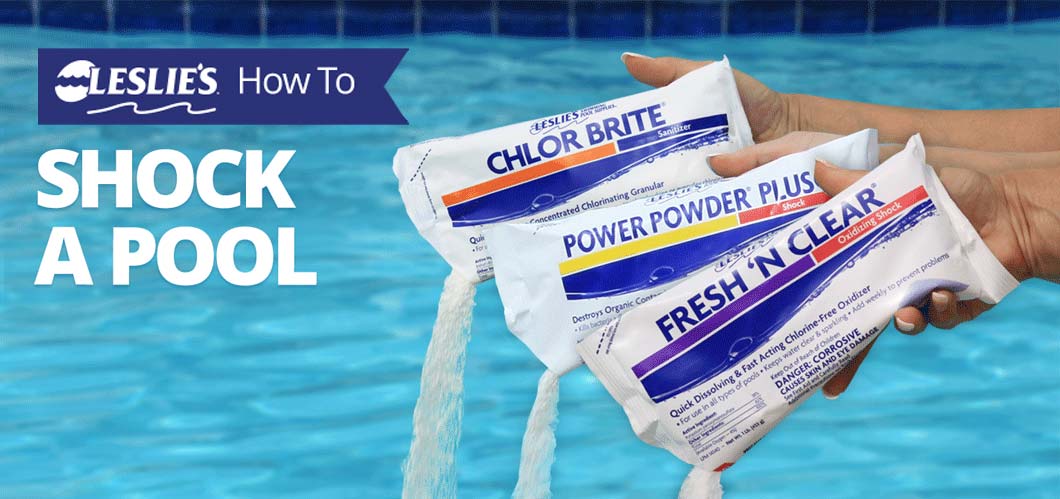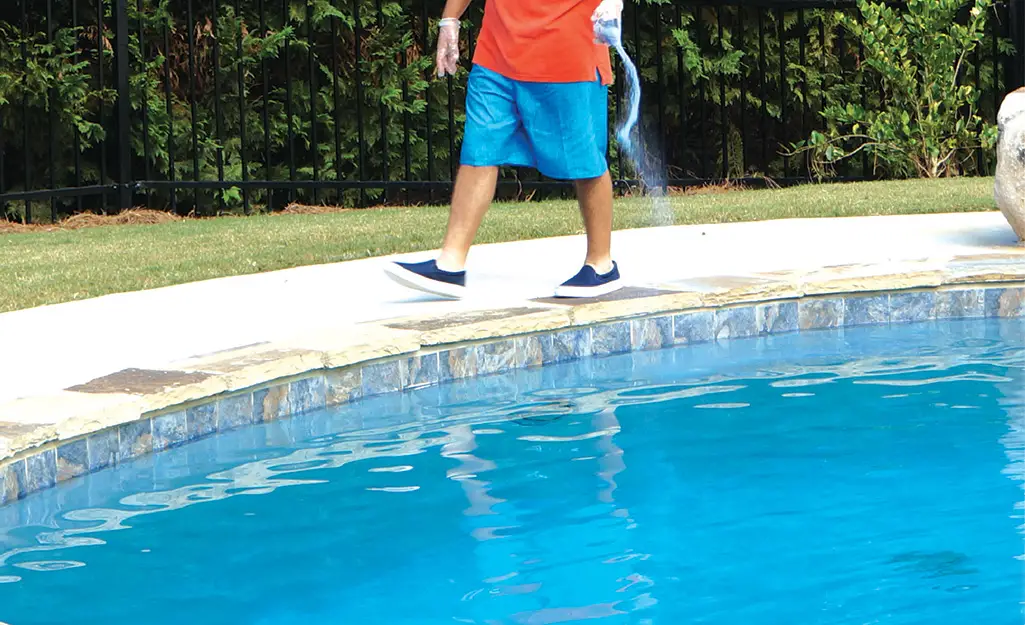To shock a pool, follow these steps: Test the chlorine level, adjust pH if necessary, add the appropriate amount of shock directly to the water, and run the pool pump for at least 6-8 hours to circulate the shock. Whether you own a private or public pool, regular maintenance and care are crucial for ensuring safe and clean swimming conditions.
One important aspect of pool maintenance is shocking the pool, which helps eliminate bacteria, algae, and other contaminants. Shocking a pool involves temporarily increasing the chlorine level to kill any harmful microorganisms that may be present. This process is typically performed on a weekly or bi-weekly basis, or as needed.
We will provide you with a simple guide on how to effectively shock your pool, ensuring a safe and enjoyable swimming experience for all.

Credit: www.powertownsend.com
Importance Of Pool Shocking
When it comes to pool maintenance, regular shocking is an essential task that keeps the water sparkling clean and safe for swimmers. Proper pool shocking helps to eliminate harmful bacteria, algae, and other contaminants, while also maintaining the overall balance of the water. In this post, we’ll delve into the importance of pool shocking, the benefits it offers, and common misconceptions that need to be addressed.
Benefits Of Shocking Your Pool
Shocking your pool comes with several essential benefits that contribute to its overall health and cleanliness:
- Eliminates Contaminants: Pool shocking eliminates harmful bacteria, algae, and other contaminants present in the water, ensuring a safe swimming environment.
- Restores Water Clarity: Regular shocking helps to maintain water clarity by breaking down organic compounds and restoring the pool’s sparkling appearance.
- Maintains Chemical Balance: Shocking the pool helps in keeping the chemical balance intact, ensuring that the water remains safe and suitable for swimming.
Common Misconceptions About Pool Shocking
There are common misconceptions surrounding the process of pool shocking that need to be addressed to ensure proper understanding:
- Harsh Chemicals: Some people may believe that pool shock contains harsh chemicals that are unsafe. However, when used correctly, pool shock is safe and effective for pool maintenance.
- Regular Chlorination is Enough: While regular chlorination is crucial, it may not be sufficient to eliminate all contaminants. Pool shocking provides an additional layer of cleanliness and safety.
When To Shock Your Pool
Knowing when to shock your pool is essential for maintaining a clean and healthy swimming environment. Pool shock treatment should be done regularly to prevent the buildup of algae, bacteria, and other contaminants that can impact the water quality. In this article, we’ll explore the frequency of pool shocking and the signs that indicate your pool is in need of shock treatment.
Frequency Of Pool Shocking
Pool shock treatment needs to be performed regularly to ensure that the water remains clean and safe for swimming. As a general rule of thumb, it’s recommended to shock your pool every 1-2 weeks, especially during the peak swimming season. However, factors such as heavy rainfall, extreme temperatures, and high bather load may require more frequent shocking.
Signs That Your Pool Needs Shocking
It’s crucial to be aware of the signs that indicate your pool is due for a shock treatment. Cloudy or discolored water, strong chlorine odor, and persistent algae growth are clear indicators that the pool needs shocking. Additionally, if you notice an increase in skin and eye irritation after swimming, it’s likely time to shock the pool.
Types Of Pool Shock
Chlorine-based Shock
Chlorine-based shock is effective in killing bacteria and algae in pools.
Non-chlorine Shock Options
Non-chlorine shock options are gentler on skin and eyes compared to chlorine-based shock.
When shocking your pool, it’s crucial to choose the right type of shock based on your pool’s needs.

Credit: m.youtube.com
How To Shock Your Pool
Do you want to ensure that your pool water remains clean and safe for swimming? One important aspect of pool maintenance is shocking your pool. Shocking your pool helps to remove any bacteria or contaminants from the water, keeping it clear and inviting.
Testing Pool Water Before Shocking
Prior to shocking your pool, it is crucial to test the water to determine its current condition. This will help you determine the appropriate amount of shock treatment needed. Testing the water is a simple process that can be done using a pool water testing kit.
- Start by collecting a sample of water from your pool.
- Next, follow the instructions provided with your testing kit to measure the different chemical levels in the water, such as chlorine, pH levels, and alkalinity.
- Refer to the test kit’s guide to determine if any adjustments are required before shocking the pool.
Step-by-step Guide To Shocking Your Pool
Now that you have tested your pool water, you are ready to begin the shock treatment process. Follow this step-by-step guide to shock your pool effectively:
- Put on protective gloves and goggles to ensure your safety during the process.
- Calculate the amount of shock treatment needed based on the size of your pool and the test results from the water testing kit.
- Begin by pre-dissolving the shock treatment powder in a bucket of water. Follow the instructions provided on the product packaging for the correct dilution ratio.
- Pour the pre-dissolved shock treatment solution into the pool water while the pool pump is running. Make sure to distribute it evenly across the pool.
- Keep your pool pump and filter running for at least 24 hours to allow the shock treatment to circulate and sanitize the water effectively.
- After 24 hours, retest the water to ensure that the chemical levels are balanced. Adjust if necessary.
Remember, shocking your pool is an important step in pool maintenance to keep the water clean, clear, and safe for everyone to enjoy. By following these simple steps and regularly shocking your pool, you can ensure that your pool water remains sparkling and inviting throughout the swimming season.
Safety Measures While Shocking
When shocking a pool, it is important to prioritize safety measures. Follow these guidelines for a smooth and safe pool shocking process.
`protective Gear Required`
When shocking a pool, wear gloves to protect your skin. Use safety goggles to safeguard your eyes from irritation. Put on closed-toe shoes to prevent chemical splashes on feet. Wear long-sleeved shirt and pants to minimize skin exposure. ``precautions To Take Before, During, And After Shocking`
Before shocking, test pool water for pH levels. During, avoid contact with shock treatment. After shocking, wait until chlorine levels return to normal before swimming. Keep shock treatment out of reach of children. Remember to read manufacturer instructions for each pool shock product. Avoid mixing different chemicals. Store shock treatment in a cool, dry place.
Credit: lesliespool.com
Troubleshooting Pool Shocking
After you have shock treated your pool, there might be some common issues that you encounter. It’s important to address these problems promptly to ensure your pool remains clean and balanced. In this section, we will discuss the common problems that may arise after shocking your pool and provide solutions to rectify these issues.
Common Problems After Shocking
Here are some common problems you may encounter after shocking your pool:
- Chlorine Odor: If you notice a strong chlorine smell in your pool, it indicates the presence of chloramines. These are formed when chlorine combines with contaminants and are not safe for swimmers.
- Cloudy Water: Cloudiness in your pool water can occur due to several reasons such as improper filtration or pH imbalance. It can also be a result of ineffective shock treatment.
- Skin and Eye Irritation: Excessive chlorine levels or unbalanced chemical levels in the pool can cause skin and eye irritation. This discomfort might be a result of incorrect pool shocking.
- Algae Growth: If you notice green or black algae growth in your pool after shocking, it means the shock treatment was not effective in killing or preventing algae.
How To Rectify Pool Shocking Issues
Now that we have identified the common problems, let’s discuss how to rectify these issues:
1. Chlorine Odor:
To fix a strong chlorine odor, you can:
- Ensure proper filtration and circulation of your pool water
- Adjust pH levels to maintain balanced water chemistry
2. Cloudy Water:
To clear cloudy water, follow these steps:
- Check and clean your pool filter regularly
- Balance water chemistry by adjusting pH, alkalinity, and calcium hardness levels
- Run the pool pump for an adequate amount of time
3. Skin and Eye Irritation:
To alleviate skin and eye irritation, take these measures:
- Test the water pH and adjust it to the recommended range
- Regularly monitor chlorine levels and ensure they are within the proper range
- Consider using a non-chlorine shock treatment if the irritation persists
4. Algae Growth:
If you encounter algae growth in your pool after shocking, try the following:
- Thoroughly brush and vacuum the pool to remove visible algae
- Shock the pool again with an algaecide or specialized shock treatment specifically designed to kill algae
- Maintain proper chemical levels to prevent future algae growth
By addressing these common problems and following the recommended solutions, you can ensure a clean and healthy swimming pool after shock treatments.
Alternative Pool Shocking Methods
When it comes to alternative pool shocking methods, there are a variety of options beyond traditional pool shock treatments. These alternative methods can be efficient and eco-friendly ways to maintain a clean and healthy pool, without the harsh chemicals commonly found in traditional shock treatments.
Saltwater Systems
Saltwater systems are becoming popular alternatives for pool owners looking for a gentler way to shock their pool. These systems use electrolysis to convert salt into chlorine, providing a continuous and consistent supply of chlorine to keep the pool clean. This method can be a more sustainable option as it reduces the need for frequent introduction of traditional pool shock treatments.
Ozone Generators
Another alternative method for pool shocking is the use of ozone generators. Ozone is a powerful oxidizer that effectively eliminates bacteria and other contaminants in the water. Ozone generators work by producing ozone gas that is injected into the pool water, rapidly oxidizing organic and inorganic matter. This process reduces the reliance on traditional pool shock treatments and minimizes the use of chlorine, providing a more environmentally friendly option for pool maintenance.
Maintenance Tips For Sparkling Clean Water
When it comes to maintaining a sparkling clean pool, proper shocking and maintenance are essential for keeping the water clear and inviting. Implementing a regular cleaning and skimming routine, along with consistently balancing pool chemicals, is crucial for achieving and sustaining pristine water quality. Let’s delve into some practical maintenance tips to ensure your pool remains a refreshing oasis for all swimmers.
Regular Cleaning And Skimming
Removing debris and impurities from the water is vital for ensuring its clarity. Regularly skimming the surface of the pool to eliminate leaves, insects, and other floating particles prevents them from sinking and causing contamination. It’s an easy practice that aids in maintaining clean and inviting water for everyone to enjoy.
Additionally, vacuuming the pool weekly helps eliminate any debris that has settled to the bottom. By incorporating this into your cleaning routine, you can effectively prevent the accumulation of dirt and ensure your water remains crystal clear.
Balancing Pool Chemicals
Properly balancing pool chemicals is paramount for maintaining clean and safe water. Regularly test the pH levels and adjust them as needed to ensure they remain within the recommended range. Moreover, maintaining the correct levels of chlorine and alkalinity is essential for preventing the growth of bacteria and algae, thereby promoting a healthy and pristine environment for swimming.
Conclusion
By following these steps, you can effectively shock your pool to maintain clean and safe water for swimming. Remember to test the water regularly and make adjustments as needed. Keep your pool shock schedule consistent for optimal results. A well-shocked pool ensures enjoyment and relaxation for everyone who swims in it.





